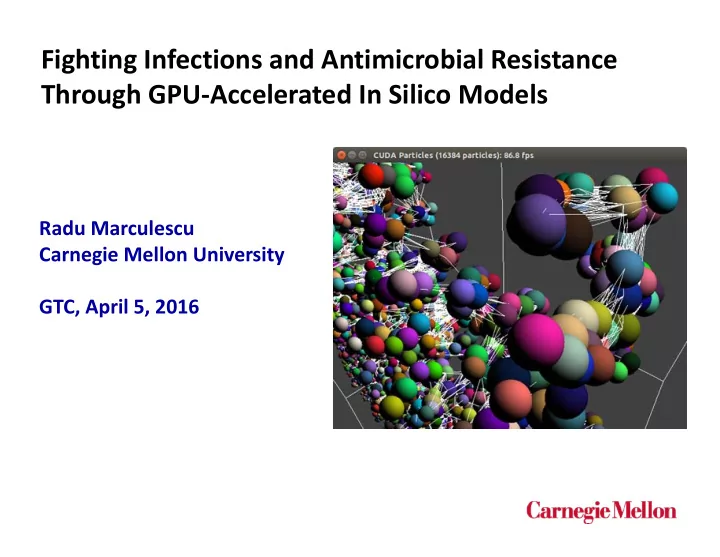

Fighting Infections and Antimicrobial Resistance Through GPU-Accelerated In Silico Models Radu Marculescu Carnegie Mellon University GTC, April 5, 2016
Bacteria are among the earliest forms of life that appeared on Earth billions of years ago. Studied since 1676… Bacteria are of immense importance because of their extreme flexibility, capacity for rapid growth and reproduction. 2
The fight against bacterial infection represents one of the big challenges of modern medicine. Focus on intercellular communication to understand behavior at population-level 4
Mathematical characterization of the collective dynamics of such bacterial swarms represents a major challenge Having a quantitative model of pathogen interactions is crucial for understanding how to fight them. 5
This presentation focuses on the “network” paradigm and ways to engineer communication Biological networks Cellular communication Silicon networks On-chip communication Bacteria form a “social network” to coordinate their behavior, build the biofilm and resist treatment. 6
A New Frontier – Quorum Sensing. QS is a density- dependent collective behavior that enables communication + + + LasR LasR virulence virulence lasI lasI lasR lasR LasA LasB ToxA AprA AI XcpP XcpR LasI LasI LasR LasR QS upregulates multiple virulence genes [G. Wei, Marculescu, NanoCom, 2014] Gram-negative bacteria use largely homologous QS networks, where the AIs are detected and regulated via genetic circuits. 7
Bacterial biofilm: Use Twitter-like metaphor to explain participants and network formation Intercellular network (c) (a) @bacteria: generate public goods (EPS) or virulence Signal molecule (molecular tweet) EPS/Virulence (b) (d) Intracellular network Wild-type cooperator Signal-blind cheater Signal-negative cheater [G. Wei et al., ACM BCB, 2015] The structure and dynamics of the inter-cellular communication network is heavily influenced by its environment 8
Bacterial population dynamics is a complex problem. Direct wet-lab experimentation is costly and often impractical. Nutrition Bulk layer Diffusion layer High-Accuracy = More iterations Biomass layer 0.1 0.01 0.001 150 Bacteria Iterations 100 Initial state Physical Epoch Biological Epoch 50 No Yes 0 Threshold 74 82 90 98 106 114 122 reached? Number of Particles (x1000) Experimenting with efficient GPU kernels using NVIDIA Thrust allows to achieve 100x acceleration with GTX980 GPUs. 10
Parallelize all agents on the GPU. Execute many of these physical interactions concurrently • Arrange the data by physical location • thrust::sort_by_key • For each agent • Examine adjacent grid space • Utilize __shared__ cuda memory • Determine movement vectors between agent and all other cells • Move agent with movement vector • Repeat until system approaches steady state • thrust::transform_reduce to get total movement in the system GPUs allow us to maintain high accuracy during the physical interactions within reasonable time constraints (hours vs days)
S4 – 1/3WT, 1/3SB, 1/3SN: Bacteria communication enables social intelligence (“molecular tweeting”) (300x300x500 μ m 3 ) Red: WT Blue: SB Yellow: SN Green: EPS t=0.2 hrs t=10 hrs t=24 hrs (a) (b) (c) Link
Dynamics of network evolution (b) (c) (a) (f) (d) (e) (i) (g) (h)
Effect of QSIs 10:30 12:47 14:00
This presentation focuses on the “network” paradigm and ways to engineer communication Biological networks Cellular communication Silicon networks On-chip communication Bacteria form a “social network” to coordinate their behavior, build the biofilm and resist treatment. 22
Parallel programs enforce correctness through communication (i.e., synch primitives and cache coherence) [V. Balaji et al., WAX 2016] Physical interactions are computationally-intensive and require 23 new approaches to heterogeneous parallel computing.
Novel distributed CPU-GPU architecture can take advantage of the data-locality between GPU cores Shared Mem Shared Mem … … SM SM SM SM L1 $ L1 $ Shared Mem Shared Mem … … SM SM SM SM L1 $ L1 $ Low-Latency Nearby Memory Access High-Latency Memory Access … Global Memory Reduce global access by using low-cost data accesses from adjacent GPUs on an integrated distributed system
How about future architectures? Can we design an on-chip Computational Microscope ? CPU/GPU … CPU/GPU L1 L1 L1 NI L1 NI L2 CPU/GPU To other L1 Router Cluster routers concentration … L1 NI L1 NI CPU/GPU CPU/GPU To L2 … CPU/GPU CPU/GPU Cluster_1 Cluster_N wired link NI: network interface wireless link VFI-mesh VFI-mSWNoC 1.2 Traditional Arch. NVFI EDP w.r.t. 1 Mesh L2 0.8 0.6 0.4 CPU/GPU Modules CANNEAL FFT LU RADIX VIPS WATER Efficient Wireless NoC Architectures [R. Kim et al., IEEE TC 2015]
There is a lot more to explore… Biofilm Microbiome Intra-cellular Dynamics Molecular Interactions comp. models wet lab Molecule Bacterium (single cell) Protein Need ~ 10 ODEs Pairwise molec. comparison ~10 4 -10 6 integer per bacterium to characterize intra- updates per pair cell processes SoC-based Computational 1-2 hrs to simulate Microscope 48-72 hrs to obtain in lab Inter-cellular network Global molec. Biofilm interaction Groups of cells (10 3 ) ~ 10 4 interaction # Sequences: eqns. (chemical & ~10 6 -10 10 physical processes) # Graph edge trav- in silico prediction of gene/protein -ersals: ~10 10 -10 15 families & molecular pathways Population of cells (10 6 -10 9 ) Population-scale interaction Need ~ 10 7 -10 10 eqns. # species per micro- for biofilm dynamics biome: ~10 2 -10 4 (chemical & physical # individual cells: processes) ~10 10 -10 13
Summary • GPU-based simulation is crucial for obtaining faster than real- time results. Only about 1-2 hrs are needed to simulate a scenario that may take 48-72 hours in the lab • Network metrics correlate well with biofilm metrics and can explain population level behaviors of biological significance. Solid basis for studying socio-microbiology… • Inter-cellular communication is crucial for understanding biological systems (which are or should become of interest to computer engineers…) Contributors (in no particular order…) G. Wei (CMU), I. Cazan (CMU), L. Chieh (CMU), K. Bhardwaj (CMU), C. Walsh (CMU), W. Ehrett (CMU), G. Carvajal (CMU), B. Lucia (CMU), L. Hiller (CMU), M. Sitti (CMU), P. Pande (WSU), A. Kalyanaraman (WSU), R. Kim (WSU).
Recommend
More recommend